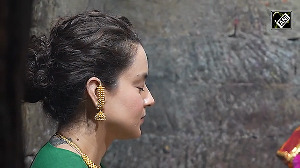At 6.15 p.m on saturday, when the whole nation will be celebrating the festival of lights with their families, with some flying off to distant lands on exotic vacations, there is one particular community that would still go to work.
Welcome to the tiny but growing breed of stock market aficionados who will be headed towards their stock brokers' offices with their families in tow for their annual pilgrimage of Muhurat trading.
Ethnic Look And Feel
For a change, stock broker offices will take on a distinctly ethnic look with neatly made rangolis and innumerable diyas lined up to welcome the mother goddess Lakshmi, and of course the clients and their better halves.
Jeans and khakis will give way to saris, silks, and long tresses with perfumes getting a bit louder. A heady aroma of roses and marigolds permeates the air as soon as you enter the gates of these modern-day casinos, carefully avoiding the diyas that line the aisle.
A mouthful of kaju katlis and many handshakes later, when you finally enter the dealing room, the computer screen wears a swastik etched in vermillion with shubh and labh written on the multimedia speakers, never mind the cleaning the office boy will have to do on Sunday.
The children are in awe of the recognition and respect their father commands, while the spouses do a quick yet discreet reconnaissance of which of the beautiful faces are guests and which are not.
Global Outlook, Indian Core
The Muhurat trading appears to be the only link the broking community retains with its rich past. The trading ring has given way to the computer links and the only place you see the famous Gujarati topi is in the teak-framed photos of yesteryears.
While the outer paraphernalia has changed, the Dalal Streeter remains very much agile and retains its shrewd understanding of the markets and the various products.
In no other country in this world has the transitions from paperless trading to demat and then to Index and Stock derivatives happened as quickly and as successful. Even while Century's "Param Sukh" has given way to Italian suits, there is no breaking away from the practice of Muhurat trading.
Lessons From The Post
For the trader, it pays to buy a day before and sell on the Muhurat trading day.
A study of the last seven years show that on all the occasions the Sensex closed on a higher note on the Muhurat day. Most traders, in fact, buy on the Muhurat day.
The chances of selling on the next day at a loss are fair as, in four out of seven years, the Index has closed lower on the subsequent day. It pays to stick to the small-caps for trading as returns are usually better. In all the seven years under study, the returns in the BSE 500 are more than the Sensex.
Today's Muhurat trading will be the first time the Sensex is in five digits. For the next 87,000 odd points this is not going to change.
Considering the fact that returns in this Samvat have been close to 62 per cent more than the cumulative return of the preceding two years, the probability of the markets doing an encore is less. But then optimism is what Muhurat is all about.
Happy investing!







 © 2025
© 2025